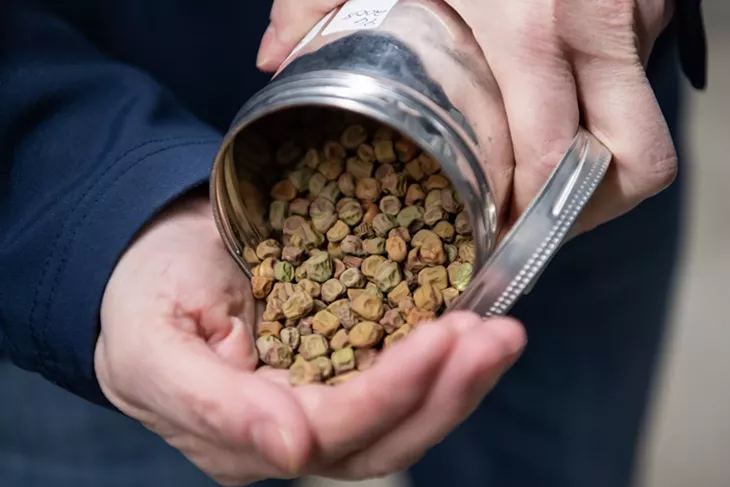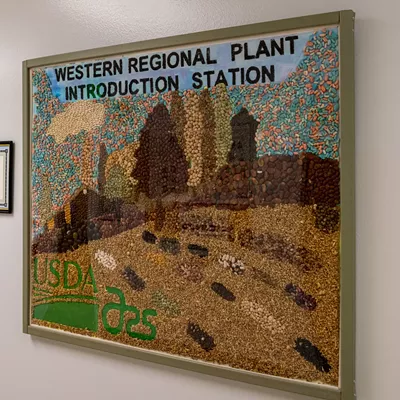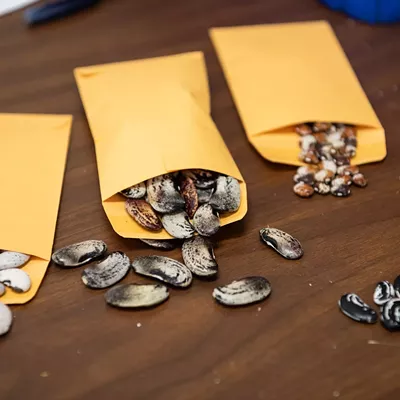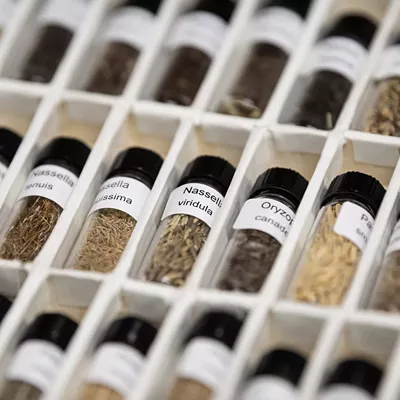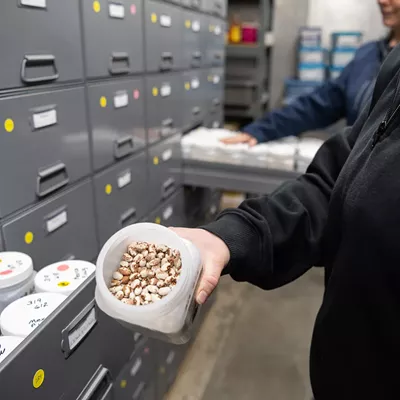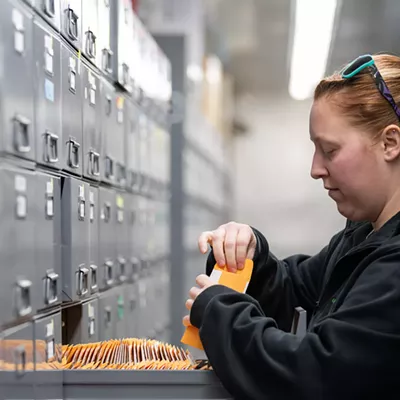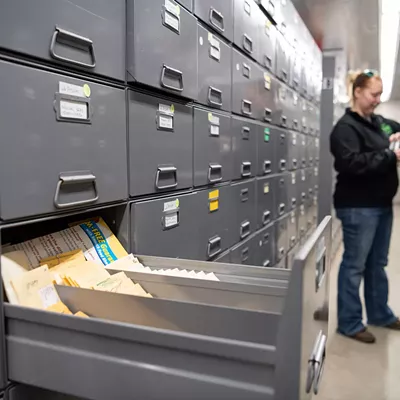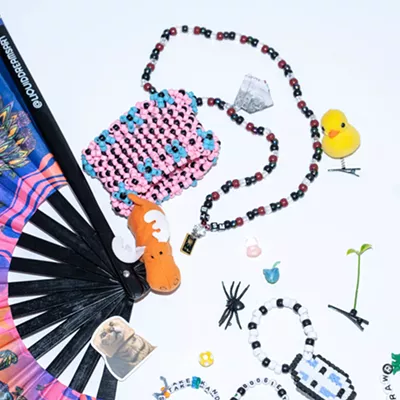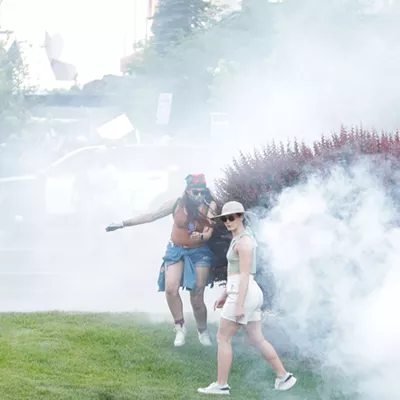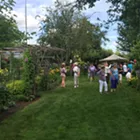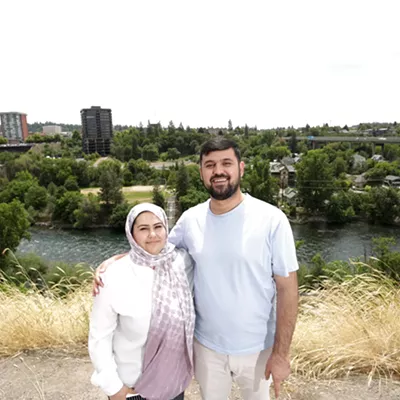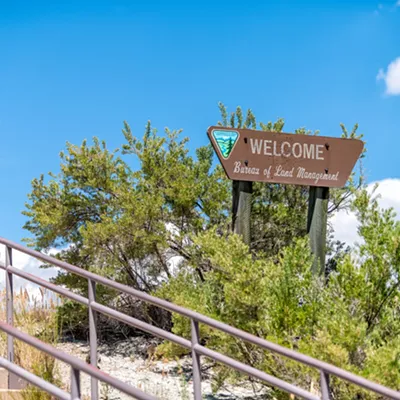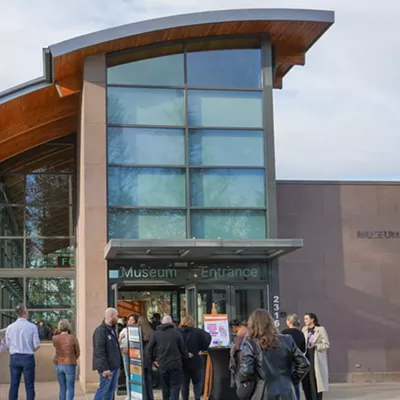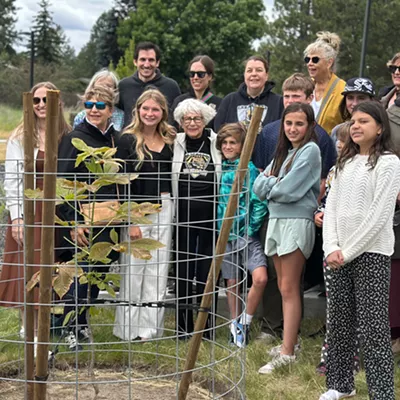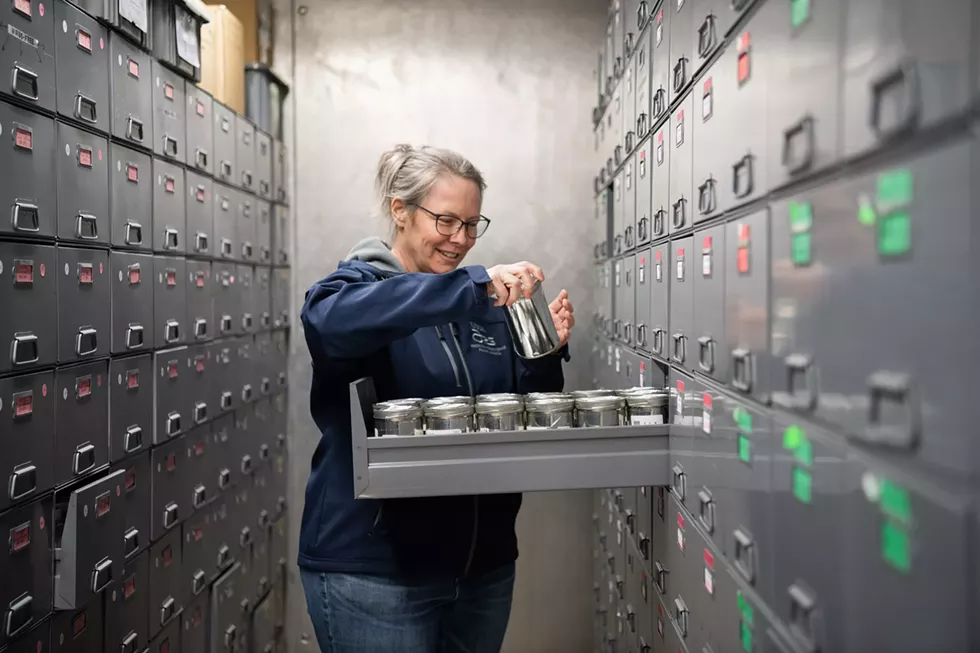
Tucked inside a nondescript building on Washington State University's Pullman campus is a bank holding an abundance of the world's wealth, where row after row of temperature-controlled filing cabinets store something far more precious than savings bonds or artwork: seeds.
Unlike the gold or jewels you might find tucked away in safety deposit boxes, precious heirlooms of a different type are secured here, part of a living gene bank of diverse plant material that can help safeguard the world's food supplies against disaster.
As the only bank of its kind in Washington, and one of only 19 around the country, this facility is an integral part of an international strategy to maintain a diverse pool of plant genetics across hundreds of locations worldwide.
A better-known global version of this seed bank dubbed the "Doomsday Vault" is tunneled into the permafrost in Svalbard — a Norwegian archipelago not far from the North Pole. Opened in 2008, the Doomsday Vault holds more than a million varieties of seeds in natural cold storage, away from the looming dangers of war, climate change, energy crises and pests.
Think of that icy Nordic vault as the backup to the backup to the seed bank on the Palouse, which also has a layer of redundancy with copies of about 70 percent of its seeds stored at another gene bank in Fort Collins, Colorado. About 30 percent of the seed varieties kept in Pullman are backed up in Svalbard.
With well over 100,000 containers holding different kinds of peas, lentils, beans, lettuces, grasses, flowers and more, Pullman's bank has one of the most diverse collections in the national system, and requires a staff of more than two dozen people to operate. In addition to shipping different seeds out to researchers and plant breeders around the world, the team also works in greenhouses and fields to constantly regenerate different crops to ensure the seeds in the fridge remain viable and genetic diversity isn't lost to history.
Unlike the Doomsday Vault, which only stores dry seeds, Pullman's program also maintains what are known as "clonal samples" for species that produce few true seeds, such as garlic or rhubarb.
"It is a living collection," says Marilyn Warburton, research leader for Pullman's program, which is part of the U.S. Department of Agriculture's seed bank network. "It has to be regenerated. Things like the garlic collection, for example, are not maintained by seeds, they're maintained by little garlic bulbs that do not store more than a year, so the entire collection has to go out into the field and come back every single year."
With only a couple dozen crops dominating food supplies — like corn, wheat and rice — farms are becoming more vulnerable to pests and other disasters, but the bank's heirloom crops can help researchers identify resilient alternatives. In addition to food crops, WSU's seed bank also houses valuable forage crops for livestock, turf crops, medicinal plants and oilseeds that can be used for things like jet fuel, Warburton says.
"This is a fantastic investment in agriculture and industry, not just food," Warburton says. "Our seed bank can save the world every single day."
The Pullman bank's biodiversity work is as relevant as ever. At the United Nations Biodiversity Conference in December, governments from around the world agreed to conserve 30 percent of the world's land and water by 2030, and incentivize biodiversity to restore species and ecosystems that are in decline by 2050. Species from bugs to birds are currently going extinct hundreds of times faster than the average rate over the past 10 million years, according to the U.N., a fact that spells disaster for the human species if things don't change soon.
"Nature and biodiversity is dying the death of a billion cuts, and humanity is paying the price for betraying its closest friend," U.N. Under-Secretary-General Inger Andersen told conference attendees. "Nature provides the very essence of life. Technology cannot replace the trees, the soil, the water, and the species that teem in them. We have no other world to flee to. When the web of life falls, we fall with it."
ALL THE DIFFERENT CHICKPEAS
Inside a narrow workspace on the main floor of Pullman's seed bank, it's easily about 75 degrees Fahrenheit on a Friday morning in early January.
The giant fridge on the other side of the wall stays cold on the inside by pumping out lots of heat, so it's more than a little toasty as staff sit at their computer stations and use razor blades to sort and clean different batches of seeds. In the last year they shipped tens of thousands of seed packets to researchers in more than 35 countries including China, Canada, Morocco, Kazakhstan, Malaysia and more.
With her hair up in a ponytail, Lisa Taylor, the seed bank's manager, ignores the heat and excitedly throws on a blue winter coat with the USDA Agricultural Research Service logo on it as she prepares to step into the walk-in cold storage that takes up most of the building.
Ideally, the temperature inside the seed bank is kept at about 4 degrees Celsius (about 39.2 F) with fairly low humidity, about 15 to 20 percent, to keep the seeds viable for years to decades, Taylor says.
Inside the massive refrigerator, Taylor walks down narrow aisles of cabinets, opening drawer after drawer of labeled manila envelopes and plastic containers, each containing specific seeds. One drawer holds a collection of several different lima beans from Turkey. Another holds a variety of safflower seeds.
"One of my favorite things is to show people all the different chickpeas, because in different countries they prioritize different things," Taylor says, opening a drawer with colorful varieties. "This collection trip was obviously really cool because they got a lot of different colors — there's green, there's pink, there's white-ish."
She opens one container and dumps dozens of shriveled jet black chickpeas into her hand, and Julia Zaring, who manages the seed bank's farm, quips that she'd be interested to see how they'd look as hummus.
While the USDA team on campus maintains the bank and fulfills research requests, Zaring and her team are employed by WSU with federal pass-through money to do the in-field work of planting, harvesting and cleaning the seeds to replenish the stores.
"Have you ever seen lettuce seeds before?" Taylor asks with a smile, walking to a corner of the refrigerated room. She opens an envelope with seeds from the 1980s and pours hundreds of the tiny gray flecks into her hand. Sometimes the lettuce seeds are black or brown or white, and Taylor says it's amazing to see how the teeny seeds grow into massive heads of edible greens.
Zaring's relationship with the lettuce is a bit more complicated, as her team on the farm near the Moscow-Pullman highway has to touch every seed (each smaller than a grain of rice) to remove any traces of natural latex before they're ready for storage.
"That white milky stuff when you break a piece off of the normal plant will harden into these orange blobs, and we have to pick all of that out," Zaring says.
Cutting-edge equipment on the farm helps the team do some of the initial processing, but Zaring's staff does the final cleaning and picking by hand.
Downstairs from the main cold storage is an even colder fridge kept at about minus 18 C (minus 0.4 F) where some seeds are stored for even longer periods of time.
"We put it in here especially if we know we can't regenerate it any time soon because we want to maintain that viability until we get a chance to grow it," Taylor says. "Or, if it's a really sensitive one like the lettuce, every time we get a good harvest we split it up so one inventory stays here and one inventory goes into the cold room upstairs."
Each group of one species of seeds, gathered at a specific time and place, is called an accession, and there are 101,195 different accessions at the Pullman bank.
"An accession is collected all at once, either at a market, in the wild, at a farm, or wherever it is found, and it's all representative of one species," Taylor says. "It might be from multiple plants, it might be one plant, or it might be considered an accession because of the uniqueness of the area and time it's collected."
The seed bank's collection is divided into five categories, each with its own curator: forage legumes, such as clover and alfalfa; grasses, such as turf, rangeland, and wild species; beans (there are about 18,000 samples in this category alone); pulse crops, such as lentils and peas; and horticultural crops, which includes pretty much everything else, research lead Warburton says.
Some of the varieties in the bank are more than 50 years old and still germinate fairly successfully when tested, which often looks like placing seeds on a moist paper towel until they sprout. The curators are in charge of testing items in their part of the collection on a regular basis to figure out which crops need to be planted and harvested for a new batch of seeds next, Warburton explains.
With the industrialization of farming leading to monocropping (growing a single type of seed over a large amount of land) and a changing climate awakening new pests and increasing instances of drought or flooding, the diverse options available in the bank are critical, Taylor says.
"I wish that more people understood and appreciated how important this is," Taylor says. "Early breeders and agronomists understood how important this was and tried to sound the alarm when they would see bottlenecks and problems cropping up. But I think a lot of breeders are singularly focused and don't really think about the broader picture of our whole food system and our environment and how this is going to affect it."
"Farmers will face problems in the future. Consumers will want new things in the future. We don't know what they are yet, but the solution's in the gene bank."
FROM 87 GARLIC VARIETIES TO BEYOND MEAT
The U.S. started collecting seeds from around the world in 1898 for diverse crop introduction, and by 1946 (after a delay caused by WWII) multiple gene banks like the one in Pullman were started to help store the country's growing collection of plants waiting to be introduced into agriculture. The campus, at the time known as Washington State College, was chosen due to its favorable climate for storage, as the program started in a root cellar, Warburton says.
Now, seed banks like the one in Pullman provide seeds to researchers for free so that humanity as a whole can benefit and learn more about specific genes and plant traits.
For instance, research into protein-heavy varieties at the Pullman program was helpful in developing plant-based meat alternative Beyond Meat, which is largely made up of pea and fava bean protein, Warburton says.
"Farmers will face problems in the future. Consumers will want new things in the future," Warburton says. "We don't know what they are yet, but the solution's in the gene bank."
A pressing concern among food growers is that diseases and insects continue evolving, with climate change enabling some pests to migrate farther north or overwinter where they never used to, Warburton says.
"They're expanding their range, and becoming a problem for farmers," she says. "But there are different varieties of all the different plants that farmers grow that resist specific diseases or insects, and the genes for those can be identified and moved into new varieties, new cultivars for farmers."
The bank and its cousins around the world aren't just helping with research, either. The theoretical worst has already happened in places like Syria, which had to draw upon backups in the Svalbard vault to regrow many varieties once stored in Aleppo. Dedicated scientists also rushed suitcases of seeds out of the country during wartime to save their collection, Warburton says, something she learned from scientists who worked for that bank's parent program, the International Center for Agricultural Resources in the Dry Areas, or ICARDA.
More recently, some buildings and regeneration fields that are part of a valuable seed bank in Ukraine were destroyed early last year by Russian bombing, emphasizing the need for seed backups around the world.
"Backups are really important," says Warburton, who co-authored a piece for CSA News, an agriculture professional magazine, last fall asking everybody to respect the world treasure in Ukraine. "As public scientists we can't dictate policy, we can't tell people what to do, but we can ask people to remember what's important."
While most of the research enabled by Pullman's seed bank is conducted elsewhere, there is some work being done on campus.
For Alex Cornwall, a seed bank technician who is getting a doctorate in horticulture, that hands-on research has focused on checking that the various lettuce seeds in the bank match their labels.
Inside a greenhouse on the east side of campus, Cornwall — whose work boots, jeans and pullover hoodie matches the de facto uniform of team members who work in the dirt daily — walks through room after room where he is growing dozens of plants from all over the world.
Unlike the big round heads of lettuce you see in stores, many of the lettuces here have grown to the point where long stalks shoot up several feet in the air with leaves spread inches apart. One long stalk featuring dark red leaves is an African variety, Cornwall says.
While many plants turned out just as expected, others he tested turned out to be prickly thistles that are common weeds in this area.
As part of his project, Cornwall is looking for small differences in specific sections of DNA for plants of the same species, so that the identification process can be even easier and more cost effective in the future.
"It also provides more accurate descriptors and identifications for breeders who are requesting it and researchers who need it," Cornwall says. "So when they ask for it, it's not something completely different."
Getting the wrong type of plant could possibly ruin a project, so the work is important.
Cornwall works under horticultural curator Barbara Hellier, who oversees the seeds for a huge variety of crops such as beets, chard, leeks, chives, medicinal and culinary herbs, and garlic.
The garlic bulbs are kept at 14 C in a basement room near the greenhouses, because the 4 C cold storage would actually stimulate some of the varieties to start sprouting early, as that temperature mimics the winter that those species expect, Hellier says.
There are 87 varieties of allium — garlics — native to the U.S. and many of those are native to the West because they like to grow in dryland areas with rainy springs and dry summers, Hellier says.
Every year each of the garlic varieties get harvested, dried, cleaned and prepped for planting in the fall so they can grow until the next summer.
"It's one of our most labor intensive collections," Hellier says.
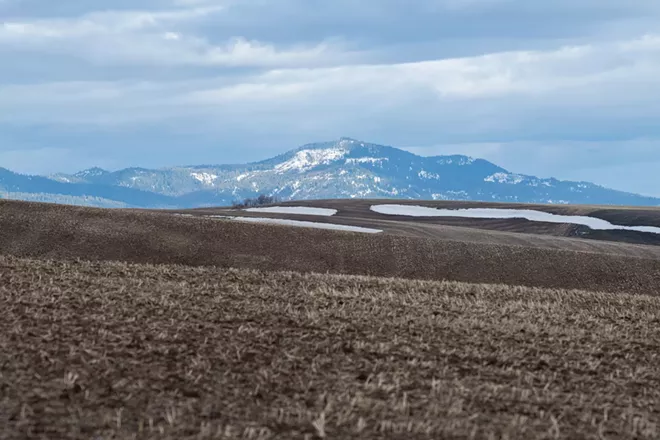
SEVENTY YEARS AND COUNTING
While all of the garlic for next year has already been planted at the seed bank's farm on the north side of the Moscow-Pullman highway, most of the other plants won't go in the ground until later this spring, says Zaring, the farm manager.
Some rows of soil on the farm get lined with metal cages so the team can cover certain plots with a fine mesh cloth to prevent cross-pollination, she says.
"We try very diligently to make sure that our genetics are going to stay as pure as possible," Zaring says. "We're trying to prevent them from crossing with wild relatives."
Meanwhile, some crops need to be grown on other USDA farms maintained in Central Ferry (where state Route 127 crosses the Snake River south of Dusty) and Prosser, depending on the conditions they thrive in and how far apart they need to be planted to prevent cross-pollination, she says.
Multiple buildings on the Pullman farm are filled with equipment that's key to the harvest, storage and cleaning of the seeds. A decades-old thresher sits in the shop outside Zaring's office. A room in the next building holds dozens of paper and mesh bags of drying plants waiting to be harvested for seed.
As Zaring walks into the seed-cleaning room, two workers meticulously pick through lentils on rubber platters, using a piece of metal to push aside any twigs or broken, cracked or shriveled pieces to be tossed out, while keeping the healthy mature seed.
A '70s-era blower in the room can do part of that work, pushing just enough air through a tube containing the seeds to remove many of the smallest broken pieces and lighter twigs, while the better lentils float in the air closer to the bottom before settling into a container.
A tool by the window nicknamed the "gravity deck," meanwhile, enables the staff to swap out different-textured plates to sort bad seeds from the good. Vibration moves seeds up or down each plate depending on the texture — the plates range from fuzzy felt to mirror smooth metal — and the pieces fall into channels for further picking, Zaring says.
For each plot that's planted on the farm, Zaring's team plants about 100 seeds. There may be multiple plots for each type of crop.
"Beyond that you're not going to get much more genetic diversity," she says.
In recent years, the program has started replanting old varieties of seeds that her team has never dealt with before, so they also have to figure out how best to grow, process and clean them.
"This has been an ongoing process for the last 70-plus years," Zaring says. "Sometimes we're making up the rules."
As someone whose dad used to farm wheat in the area that went to Anheuser-Busch for beer production, Zaring says it's great to see the connection with her current work at the bank and know that many related crops are now grown around the world.
"A lot of the cultivars come from the genetics in our seed bank and have been bred from our seed bank. It's really cool to know that things my dad used to grow were started here," Zaring says. "We do really cool work." ♦

